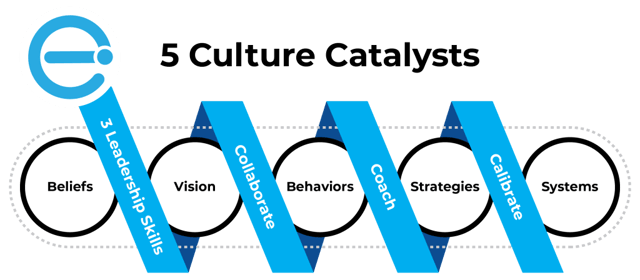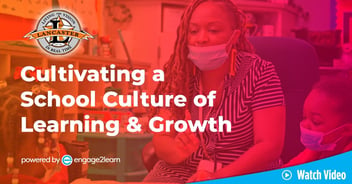The Craft of Culture-Focused Leadership: 5 Culture Catalysts + 3 Skills
What if the reason decades of reform, including billions of taxpayer dollars spent on professional learning, technology, resources, and programs have not created a sustainable solution is because these solutions are answers to the wrong type of problem? The time, money, and energy spent providing a technical or strategic solution to an adaptive problem can only become an investment if the leader uses a culture-focused methodology. In order to create adaptive solutions in public education, engage2learn has defined a culture-based change management process.
Solving the Right Problem
For decades, American education has been “improved,” “reformed,” “redesigned,” and “transformed.” Because most seem to think the solution to modernizing the public education system is about generating the single, right idea, a plethora of promising programs are paraded through school districts on a cyclical basis, and a new parade begins with each change in executive leadership. When holding a hammer, everything looks like a nail. What if the reason decades of reform, including billions of taxpayer dollars spent on professional learning, technology, resources, and programs, have not created a sustainable solution is because these solutions are answers to the wrong type of problem? Ronald Heifetz, founding director of the Center for Public Leadership at the John F. Kennedy School of Government, Harvard University, and co-founder of Cambridge Leadership Associates, writes that trying to solve adaptive problems with technical solutions is a waste of time. In Red Zone, Blue Zone: Turning Conflict Into Opportunity the authors outline three different types of problems: tactical, strategic, and transformational (Osterhaus, Jurkowski, & Hahn, 2015).
The solutions to tactical problems in public education would be programmatic or initiative-driven. How many educators can relate to initiative overload? The solution to strategic problems in education would be long-term planning across the system, and nearly every school district has a strategic plan. As Peter Drucker most famously put it: “Culture eats strategy for breakfast,” (Business Strategy, 2011). Of course, educational leaders need to be strategic; however, the time, money, and energy spent providing a technical or strategic solution to a cultural problem can only become an investment if the leader uses a culture-focused methodology. The solution to transformational or adaptive problems depends upon the engagement of people who inhabit the culture of that community. These individuals must agree upon and enact solutions that change behavior, which they must discover themselves. Sir Ken Robinson, Ron Ritchhart, Michael Fullan, David Perkins, and others outline the cultural roots of the current challenges in education and how it will take a culture-based methodology to discover effective and sustainable solutions. In Leadership & Sustainability: System Thinkers in Action, Fullan writes, “Addressing an adaptive challenge requires complex learning in politically contentious situations where there are many inertial forces pulling us back to the status quo,” (2005, p. 46). In order to create adaptive solutions in public education, engage2learn (e2L) has defined a culture-based change management methodology that:
- Involves all aspects of the educational ecosystem.
- Establishes the 5 most effective levers for intentionally creating culture.
- Utilizes collaboration, coaching, and calibration to ensure sustainability.
e2L’s Culture-Based Change Management Methodology
Beginning in 2011, e2L developed a culture-based change management methodology and processes gained from a thorough review of organizational research as the foundation to our work. Over the past seven years, our organization has applied this methodology with more than 200 public school districts at every level of the system. Therefore, in addition to utilizing research in our methodology we have also gleaned insight and knowledge that continually inform iterations of our culture-based methodology from our experience and an “action research” perspective. This triangulation of our methodology foundation has been a five-year observational study of innovative businesses. We have also connected public school districts with learning opportunities in a variety of learning collaboratives and leadership academies we have facilitated, including organizations such as The Container Store, Dell, Google, GSD&M, Rackspace, Southwest Airlines, Steelcase, TDIndustries, and Whataburger. The learning from these experiences, from our experiences applying change management in districts, and from continuous and careful review of the literature regarding organizational culture, has been synthesized into the craft of culture-focused leadership, which identifies 5 Culture Catalysts that leaders can use to intentionally create an engaging, thriving culture and 3 techniques leaders can use when designing and implementing the five levers of culture. This paper will outline the culture-based change management methodology that e2L utilizes and coaches leaders to employ to create a thriving, sustainable educational ecosystem.
The Educational Ecosystem
Merriam-Webster defines culture as “the set of shared attitudes, values, goals, and practices that characterizes an institution or organization.” Leaders influence culture, either intentionally or unintentionally, by the decisions they make and the actions they take that ultimately impact the behaviors of those in the organization. Leaders of successful businesses understand the crucial role culture plays in their success and are intentional about creating a high-performance culture, one in which every person is engaged and growing. Similarly, the goal of most leaders in public education is to create an organization wherein individuals are engaged and growing, although much of the focus for engagement in school districts has been on student engagement alone. There are theories and entire programs aimed at increasing student engagement, yet if we want to ensure a healthy culture, we must look at adult engagement in the system as well. The research is pretty bleak when it comes to the workplace; author Rex Miller sums it up in Change Your Space, Change Your Culture when he writes, “…disengagement is baked into the traditional workplace,” (Miller, Casey, & Konchar, 2014, p.13). He further summarizes the research by explaining that of 10 employees, only three are actively engaged, five are doing a decent job if actively managed, and two are so toxic to the organization that companies would save money by paying them to stay home (2014). If the goal in public education is to create a culture where everyone is engaged and everyone is growing, leaders in education need to develop the skills and employ the approach of collaborating with and engaging people throughout the educational ecosystem. For more on this topic, see the paper entitled e2L Strategic Vision Methodology. To truly ensure a cultural shift, e2L has created processes that extend beyond student engagement to involve communities, families, teachers, and staff as well.
The 5 Culture Catalysts
Cultures will suffer from misalignment, neglect, and aristocratic approaches. Donna Brighton states that, “Cultures tend to be accidental, hypocritical or intentional,” (2018). In each of these scenarios, the leader determines the approach to culture. It is clear in the literature and in our own practice at e2L that leaders who are intentional are creating culture through the design, alignment, and application of the following 5 catalysts: beliefs, vision, behaviors, strategy and systems. Leaders who are hypocritical will say they value one thing and model, measure, and reward something that is in conflict with the espoused values. They might promote one set of beliefs, measure a different set of behaviors, communicate a vague vision, try every strategy that looks promising, and keep the current systems in place. Leaders who do not understand or simply neglect culture will inherit an accidental culture which may or may not be healthy or ideal and may or may not be aligned to the vision of the organization. However, leaders who utilize and align these 5 critical components intentionally create a desired culture of engagement and growth where shared beliefs are the foundation of the vision, and behaviors, strategy and systems are all aligned to that vision. The 5 Culture Catalysts include the “why” for an organization in the beliefs, include the “what” for an organization in the vision, and include the “how” for the organization in the behaviors, strategies and systems. The behaviors, strategies, and systems address the 3 levels of change required for shifting culture: behaviors are defined for each individual, strategies are defined for teams within the organization, and systems apply to the organization as a whole.
Beliefs
“To believe in something and not to live it is dishonest,” Mahatma Gandhi.
Since beliefs are the foundation of all behaviors, it is imperative to clarify which beliefs the stakeholders of the system share; this will provide the foundation for desired behaviors. I was fortunate early in my career to experience and be trained by Dr. Bill Cook and his associates who developed and facilitated a strategic planning methodology for schools for the last 30 years. One of the most important things I learned from the genius of Dr. Cook’s process, as outlined in Strategic Planning for America’s Schools, is that actionable strategy always starts with beliefs, which ground the strategy in a cultural basis. (Cook, 1988). Once an organization has discovered its shared beliefs collaboratively with the community, defined those beliefs clearly, and communicated those beliefs, the work of aligning vision, behaviors, strategy, and systems to those beliefs can then begin. The anchor of these shared beliefs, thus, creates the basis of a healthy culture. In this sense, beliefs are different from what many term “core values” in that the beliefs are not memorized and adopted by members of the organization. They are specific, shared beliefs, which are discovered collaboratively and agreed upon as the basis for a team who will design the vision. This team is representative of the entire educational ecosystem and, in our process and experience, must establish what they agree upon about learning and education in order to create a vision that they will be willing to act on and defend.
Vision
“Leadership is the capacity to translate vision into reality,” Warren Bennis.
Vision casting is an obvious role of an educational leader. Vision sets the target for where the organization is headed and is critical to the growth of the organization. However, if a leader wants the vision to be actionable and to create or influence the culture of the organization, the leader must collaborate with every level of an organization and its stakeholders to set that vision. People will not change behavior to align to a vision for which they do not feel ownership. That is, a culture of compliance or “buy-in” will only go so far. A culture of ownership, on the other hand, is the basis of a high-performance culture. Therefore, a vision and the defined behaviors, strategy, and systems to make it actionable must be created in concert with the people who inhabit the organization. As Dan Pink asserts in Drive: The Surprising Truth About What Motivates Us:
While complying can be an effective strategy for physical survival, it’s a lousy one for personal fulfillment. Living a satisfying life requires more than simply meeting the demands of those in control. Yet in our offices and our classrooms we have way too much compliance and way too little engagements. The former might get you through the day, but only the latter will get you through the night. (2009)
While in business, vision is about the future of the organization; in education where the purpose is to prepare learners for their future, the vision that can fuel a thriving organization must be about the future of the learners. When vision is only about the future of the organization, there are key elements missing that are necessary to bridge to behaviors, which are the basis of culture. Vision casting, which drives healthy culture, must include the following differentiators:
- Vision for the future of the learners
- Learner outcomes or measures of progress toward the vision
- Dashboard to communicate progress toward the vision and for the community to hold the organization accountable to the vision
In establishing our initial culture-based change management methodology, the literature was clear that organizations need to measure what they value or they will begin to value what they measure. Therefore, if leaders want to intentionally create a healthy culture, it is imperative to collaboratively create measurables with the community that align to the established vision. If educational institutions rely upon only the measurables established by federal and state agencies, the local vision for the schools will not be actionable, as individuals in the organization will continue to use the external measurables to guide their behaviors. As Thomas Edison once said: “Without execution, ‘vision’ is just another word for hallucination.”
Behaviors
“In order to make a switch, you need to script the critical moves,” Chip Heath.
Even though beliefs and vision are the foundation of behaviors, we have learned from the literature, our experience, and innovative organizations that it is important to be explicit about the ideal behaviors for each individual in the organization in order to clearly create the desired culture of the thriving educational ecosystem. To accomplish the ideal vision, an organization must collaboratively define the behaviors that will ultimately make that vision a reality for each member and the organization as a whole. e2L recommends school districts establish clarity of behaviors through the following products:
- Learner Profile
- Educator Profile
- Leader Profile
- Cultural Tenets
- Learner and Educator Protocols
Perhaps the most important lesson we have learned from our interactions with and observations of innovative businesses is that of establishing clarity about ideal behaviors within an organization, which is a key to creating a high-performance culture. In all of the organizations we have studied, defining the cultural tenets by which every person modeled his or her behavior was pivotal. In each organization, these cultural tenets were written, posted, and prevalent in conversation and action. You can read more about these findings in our blog post entitled, Cultural Tenets: Why, What, How. In public school districts, this step is often overlooked, even though it will help to ensure all of the strategies evoked to make the vision a reality actually work. At engage2learn, we established a process for educational organizations to collaboratively define cultural tenets in alignment with vision.
Strategy
“Culture eats strategy for breakfast,” Peter Drucker.
“A great piece of art is composed not just of what is in the final piece, but equally important, what is not. It is the discipline to discard what does not fit- that may have already cost days or even years of effort – that distinguishes the truly exceptional artist and marks the ideal piece of work, be it a symphony, a novel, a painting, a company, or most important of all, life,” Matthew E. May.
Drucker’s famous quote is a warning about creating strategy without first considering or defining culture. Once behaviors, including cultural tenets, are defined, strategy can then be determined in a collaborative context. As a catalyst to create culture, strategy must be clear, concise, and filtered through the lens of the beliefs, vision, and behaviors already defined by the organization. The more integrated and focused a strategy is, the more likely it will be implemented. In addition to focus, the other keys to an actionable strategy are modeling and coaching the strategy at every level of the organization.
Several notable authors have written about the importance of clear and focused strategy. The works of Gary Keller (The One Thing), Matthew E. May (The Elegant Solution, The Laws of Subtraction), John Bell (Do Less Better), Morgan and Barden (A Beautiful Constraint), and others have helped us at e2L understand the healthy tension between innovation and discipline. Steve Jobs spoke and wrote proudly about the discipline to stay focused:
People think focus means saying yes to the thing you’ve got to focus on. But that’s not what it means at all. It means saying no to the hundred other good ideas that there are. You have to pick carefully. I’m actually as proud of the things we haven’t done as the things I have done. Innovation is saying ‘no’ to 1,000 things. (2011)
The purpose of a clear and focused strategy aligned to vision and beliefs provides a decision-making filter, which provides teams and individuals throughout an organization with an effective way of making tactical decisions that culminate in the realization of the overall strategy and ultimately the vision. One way to create a clear, concise strategy in public school districts is through a learning framework. We have developed a design-thinking process that specifically engages stakeholders in a school district to collaboratively define the learner experience they desire, which will lead to the learner profile. For many decades, there has been a focus in education on standards and written curriculum. In other words, expectations have been set at the state and federal level for what will be taught and when it should be mastered by students. While the “what” and the “when” have been established by governing organizations, e2L has determined through work with hundreds of public school districts that the strategy for how learning will happen is necessary to ensure that the 16,000+ hours students spend in classrooms results in acquisition of the skills established in the vision and learner profile.
All of the operational departments within the public school district can establish aligned strategy once the vision for learning and the strategy for the learning experience has been established. Since learning and learner outcomes are the purpose of the organization, if strategy is set for operations in isolation or in conflict to the vision for learners and the strategy for learning, the organization will operate in silos instead of as a thriving ecosystem.
Systems
“Vision without systems thinking ends up painting lovely pictures of the future with no deep understanding of the forces that must be mastered to move from here to there,” Peter M. Senge.
The last of the 5 Culture Catalysts is systems. Effective systems in a successful organization will be aligned to strategy, behaviors, vision and beliefs and will be pruned, discarded or abandoned when they become obsolete. Systems impact culture the most directly since they are the way in which an organization operates on a consistent basis. When systems are in conflict with vision, the culture will be aligned to the systems rather than the vision. Examples of systems in school districts that need to be established by educational leaders and stakeholders in alignment to vision are as follows:
- Performance Systems
- Communication systems
- Recognition systems
- Feedback/Evaluation systems
- Coaching/Professional development systems
- Meeting structures
- Human Capital/Hiring systems
- Physical Environment
- Project Management Systems
For instance, if an educational organization sets up collaboration as an ideal behavior and as a part of the desired learner experience yet has a meeting structure based on one-way information sharing, this system does not align to the vision of the organization and will create a disconnect with adults in the system who perceive the vision espoused as one thing and the reality of how they are engaged, as in conflict. In Barbarians to Bureaucrats: Corporate Life Cycles, author Lawrence Miller notes: “When organizations begin to serve themselves instead of serving a purpose, they become bureaucracies,” (1989). When leaders understand and utilize culture-focused methodology, they ensure that systems and strategies are aligned to the shared vision that is the motivating force of a healthy educational ecosystem.
The Three (3) Leadership Skills for Creating Culture
“The role of a creative leader is not to have all the ideas; it is to create a culture where everyone can have ideas and feel that they are valued,” Sir Ken Robinson.
Intentionally aligning the 5 Culture Catalysts described above can establish a thriving educational ecosystem, but only if the leader of the organization employs 3 techniques during design and implementation of these Culture Catalysts. As Edgar Schein, culture expert and professor emeritus with MIT Sloan School of Management once said, “You only truly begin to understand your culture when you try to change it.” When any leader embarks on this task, they learn how robust a negative or neglected culture can be in resisting and persisting. The 3 Skills that e2L has found to help overcome resistance and enhance a leader’s culture-shifting efforts are: collaborating, coaching, and calibrating. Collaborative leaders engage others in the work of design and decision-making in effective ways to create a culture of ownership. Peter Senge calls it “shared vision” and describes the role of the administrator as one of the collaborative leader who engages the school community in creating a clear picture of the desired future and “making a collective choice about how to proceed,” (2012, p.89).
Moreover, leaders who coach or mentor others and provide ongoing coaching support systems when expecting behaviors to change are significantly more successful in enacting changes within their organization that are sustainable as well as creating a culture of growth and trust. Leaders must support the changes in behavior to see results. Beverly Showers and Bruce Joyce, pioneers in research-based coaching and training implementation, write about the impact of coaching on changing behavior for educators and producing results for learners: “Teachers who had a coaching relationship, practiced new skills and strategies more frequently and applied them more appropriately,” while “…students benefit when their teachers learn, grow, and change,” (1996).
Lastly, leaders who measure what they value and consistently model those behaviors, including systems to recognize and reward those behaviors as well, create a culture of calibration and peer accountability. When leaders model the desired behaviors, members of their organization are clear about those specific behaviors that are valued, and they will view those behaviors as the norms for reward in the system. Furthermore, those within the organization will then have identified examples of those behaviors available, and, therefore, are able to self-assess and calibrate their own behavior with the clarity of those standards. In H3 Leadership: Be Humble, Stay Hungry, Always Hustle, author Brad Lomenick affirms the value of modeling, “People would rather follow someone who is always real than someone who is always right,” (2015, p.17).
Bibliography
-
-
- Brighton, D. (2018). #1 reason for culture change success. Human Synergistics International. Retrieved from https://www.humansynergistics.com/blog/constructive-culture-blog/details/constructive-culture/2018/10/09/1-reason-for-culture-change-success
- Buerk, S. (2018, December 11). Cultural tenets: Why, what, how. Retrieved from https://engage2learn.org/cultural-tenets-why-what-how/
- Campbell D., Edgar, D., & Stonehouse, G. (2011). Business Strategy, Third Edition, Quote p. 263. London: Palgrave Macmillan.
- Collins, J. (2001). Good to great: Why some companies make the leap…and others don’t. New York, NY: HarperCollins Publishers, Inc.
- Culture. 2018. In Merriam-Webster.com. Retrieved from https://www.merriam-webster.com/dictionary/culture
- Gallo, C. (2011). Steve Jobs: Get rid of the crappy stuff. Forbes. Retrieved from https://www.forbes.com/sites/carminegallo/2011/05/16/steve-jobs-get-rid-of-the-crappy-stuff/#6cd937307145
- Gladwell, M. (2005). Blink: The power of thinking without thinking. New York, NY: Little, Brown and Co.
- Grant, A. Give and take: Why helping others drives our success. New York, NY: Penguin Books.
- Heath, C. & Heath, C. (2010). Switch: How to change things when change is hard. New York, NY: Broadway Books.
- Lomenick, B. (2016): H3 leadership: Be humble. Stay hungry. Always hustle. New York NY: HarperCollins Leadership.
- May, M.E. (2007). The elegant solution: Toyota’s formula for mastering innovation. New York, NY: Free Press.
- Miller, L. (1989). Barbarians to bureaucrats: Corporate life cycle strategies. New York, NY: Ballantine Books.
- Miller, R., Casey, M., & Konchar, M. (2014). Change your space, change your culture: How engaging workspaces lead to transformation and growth. Hoboken, NJ: John Wiley & Sons, Inc.
- Pink, D. (2009). Drive: The surprising truth about what motivates us. New York, NY: the Penguin Group.
- Ritchhart, R. (2015). Creating culturing of thinking: The 8 forces we must master to truly transform our schools. San Francisco, CA: Jossey-Bass.
- Robinson, K. & Aronica, L. (2015). Creative schools: The grassroots revolution that’s transforming education. New York, NY: Penguin Random House, LLC.
- Schein, E. (2010). Organizational culture and leadership, Fourth edition. San Francisco, CA: Jossey-Bass.
- Senge, Peter. (2012). Schools that learn: A fifth discipline fieldbook for educators, parents, and everyone who cares about education. New York, NY: Crown Publishing.
- Showers, B. & Joyce, B. (1996). The evolution of peer coaching. Educational Leadership, 53 (6), 12-16.
- Syed, M. (2010). Bounce: Mozart, Federer, Picasso, Beckham, and the science of success. New York, NY: Harper.
-




